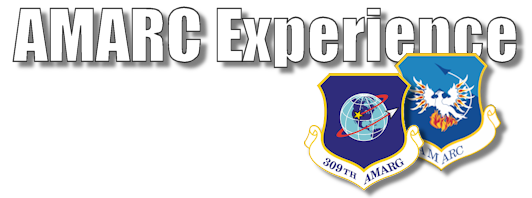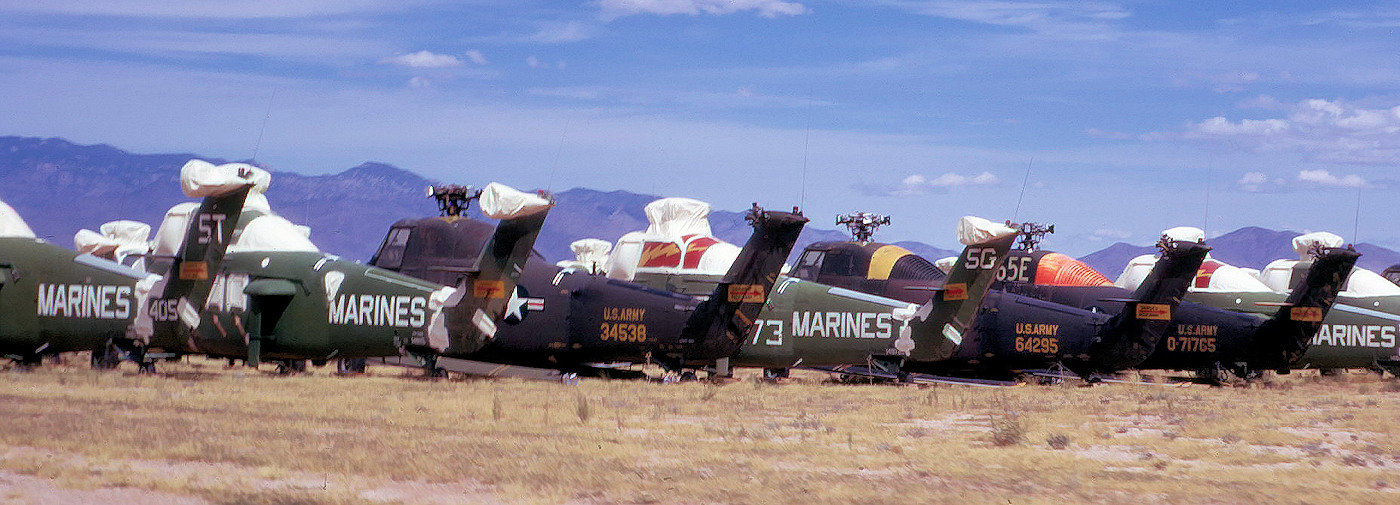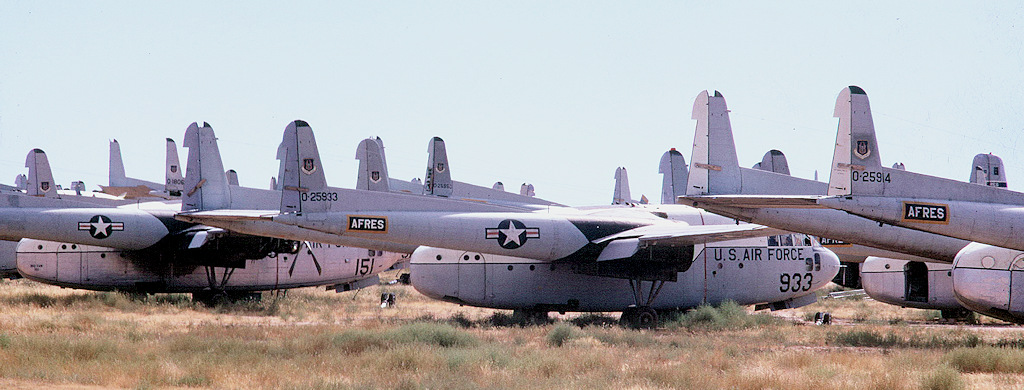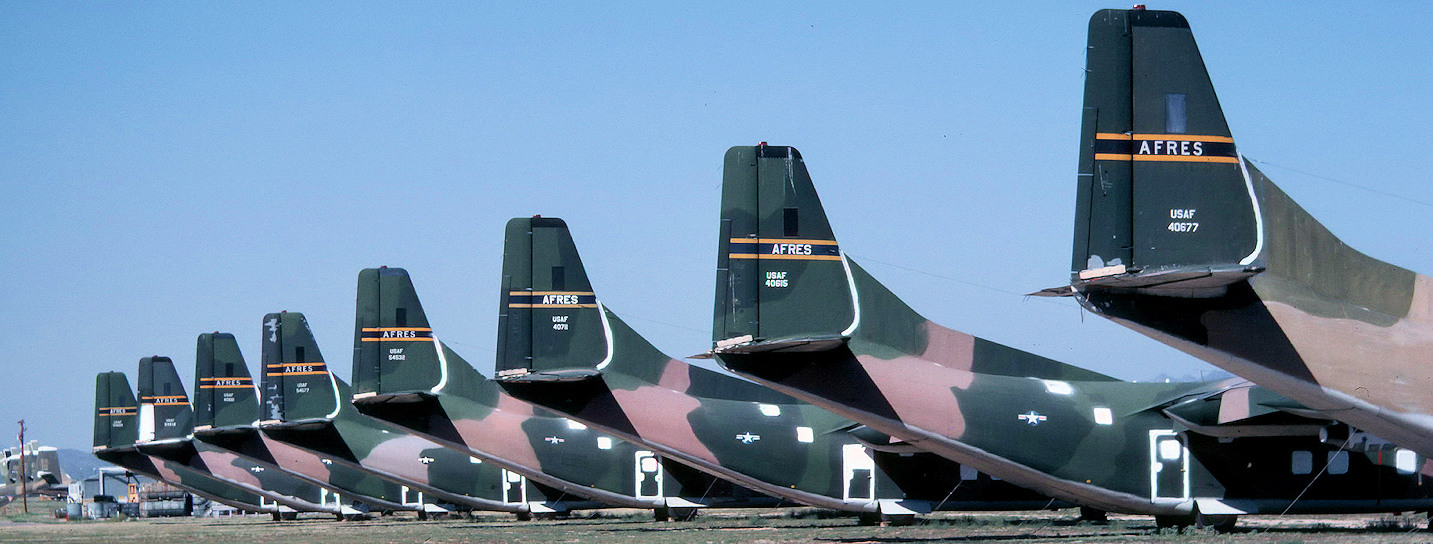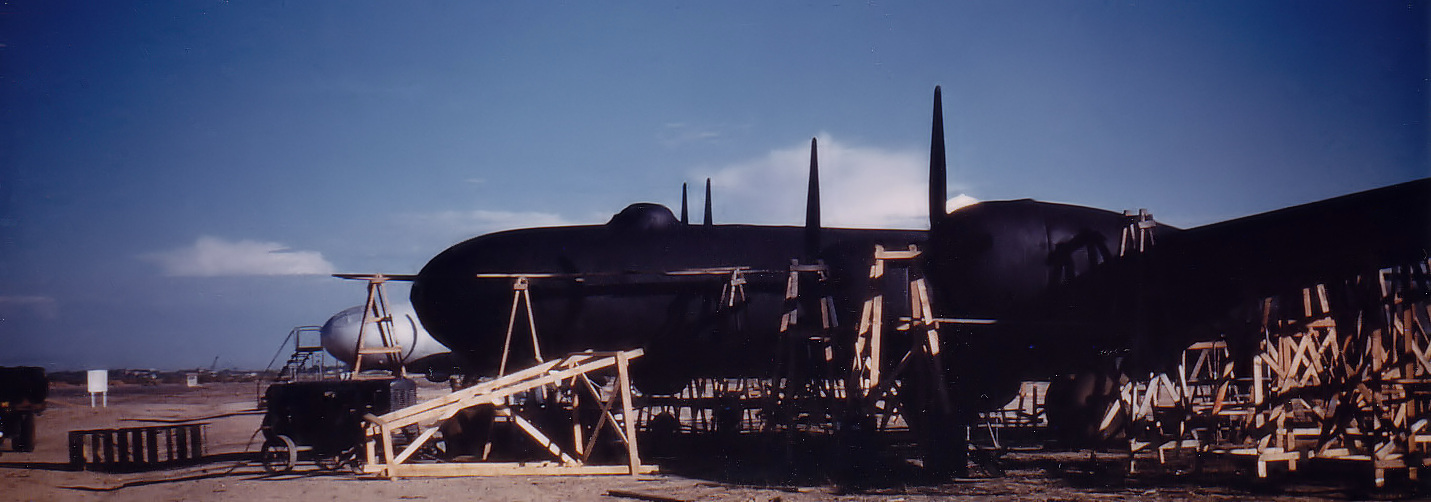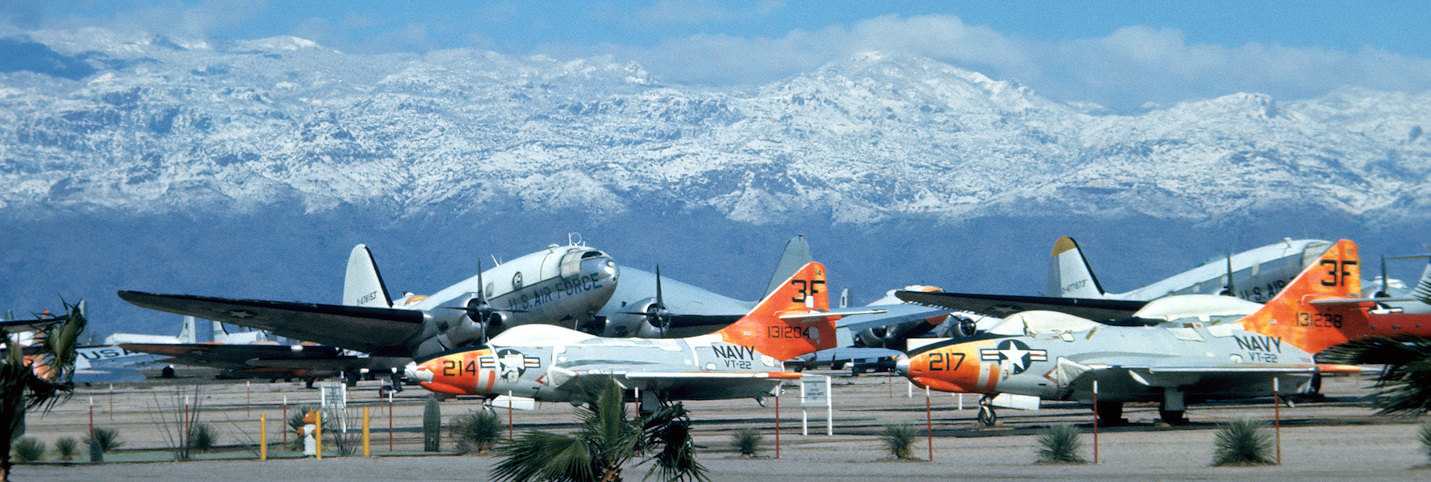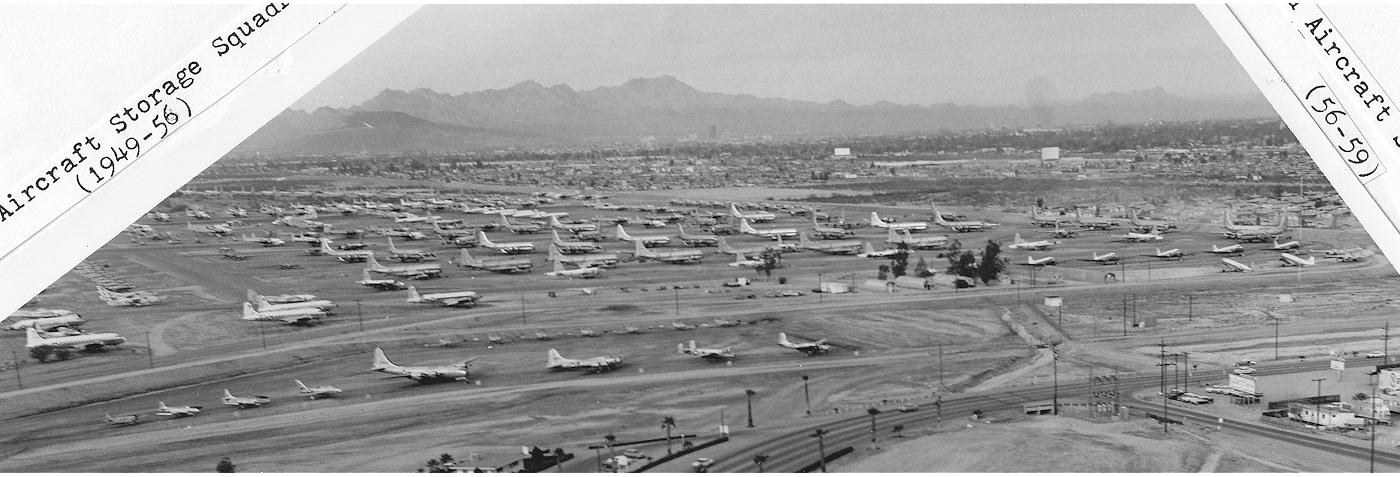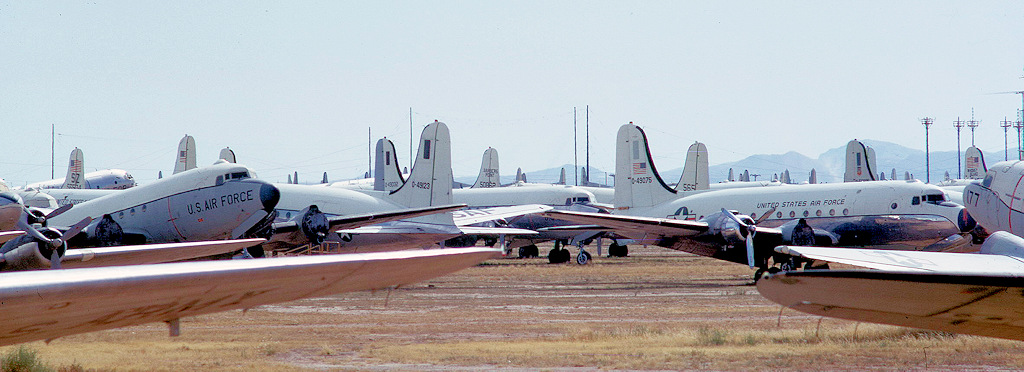Picture: Rows of B-29 Superfortress in storage at Davis-Monthan AFB.
Photo from the Colonel Schrimer Collection.
August 28th, 1948 to June 1st, 1956
On August 28th, 1948 the 4105th was redesignated the 3040th Aircraft Storage Depot, and the responsibilities of reclamation and salvage were added to the depot's mission. Over the coming years the unit will see a number of name changes but its basic mission would remain generally the same.
Towards the end of the 1940s many of the stored aircraft were re-generated when increased tensions with the Soviet Union prompted the US to increase their state of readiness. Following this the build up for the imminent war in Korea resulted in the number of aircraft stored at Davis-Monthan to reduce further with many of the B-29s being returned to service or turned over for reclamation to fulfill the spares requirement to achieve the required level of readiness.
By the end of 1951 the number of stored and excess aircraft at Davis-Monthan stood at only 267, including 202 cocooned B-29. By mid 1952 this number had dropped to 202, including 81 cocooned and 28 un-cocooned B-29. A summary of stored Air Force aircraft numbers during 1951 and 1952 can be found using the links available on the right-hand side of this page.
With the introduction to service of the mighty Convair B-36 Peacemaker and the new generation Boeing B-47 Stratojet, and the cessation of the Korean War, the now obsolete B-29s were once again retired to Davis-Monthan AFB.
|
1950 SEP |
DEC |
1951 MAR |
JUN | SEP | DEC |
1952 MAR |
JUN | SEP | DEC |
1953 MAR |
JUN | SEP | DEC |
1954 MAR |
JUN |
| 486 | 472 | 418 | 310 | 267 | 239 | 227 | 202 | 195 | 195 | 195 | 273 | 448 | 981 | 1,200 | 1,124 |
The figures in the table above represent the number of U.S. Air Force aircraft stored at Davis-Monthan AFB still listed on their active inventory. What is not included are the numbers of aircraft assigned to reclamation, or awaiting disposal.
As well as being re-generated, starting in 1953 a large number of B-29s were turned over to reclamation to supply spare parts to the operational fleet. During 1954 alone, the number of those assigned to reclamation was more than 300.
The numbers of stored aicraft remained fairly stable between 1954 and 1955, with relatively few arrivals and departures taking place. However, during 1955 and 1956 many hundreds of North American T-6 Texans were regenerated and provided to France and other friendly nations under the Military Assistance Program (MAP). Many more were authorised for reclamation use, probably to provide spares in support of the MAP regeneration programs.
Below are some of the more notable events which took place between 1953 and 1956.
1953
- Freshly converted Boeing QF-17G Flying Fortress drones arrived for short/medium term storage from the Mobile Air Material Area, Brookley AFB, AL. where the conversions had been undertaken. By mid 1956 these drones had been regenerated and had departed back to Brookley AFB for preparation to return to service and ultimate destruction.
- North American T-6D and T-6F Texans continued retirement with a large number arriving from various operational, non-training units. During 1956 these trainers were turned over for reclaimation.
- During July and August 36 Boeing B-29 Superfortresses of the 40th Bombardment (Medium) Wing, Smoky Hill AFB, KS. arrived for retirement as the unit transitioned to the Boeing B-47 Stratofortress. During July 1954 the majority of these aircraft where turned over for reclamation.
- During January and February 41 Boeing B-50A Superfortresses of the 43rd Bombardment (Medium) Wing, Davis-Monthan AFB, AZ. were retired to the neighbouring storage facility as the unit transitioned to the Boeing B-47 Stratofortress. On October 18th 1954 40 of these aircraft where turned over for reclamation. The final one, 47-0113, left storage in March and was returned to service with the 2750th Air Base Wing at Wright-Patterson AFB, OH.
- 27 Boeing B-29A Superfortresses, which were part of a batch of 87 B-29A loaned to the Royal Air Force under the Military Assistance Program, returned for storage from the UK. The Royal Air Force had used the B-29 as a 4 year, stop-gap measure to provide the UK with a strategic bomber capability before their chosen platform, the English Electric Canberra, could enter service. While in RAF service these aircraft were designated the Washington B.1. During July 1954 the majority of these aircraft where turned over for reclamation.
1954
- Arrivals included North American T-6D and T-6F Texans and Boeing B-29 Superfortresses.
- Over 100 Boeing B-29 Superfortresses were assigned to reclamation purposes.
1955
- The 3600th Combat Crew Training Wing based at Luke AFB, AZ. retired their Republic F-84E Thunderjets, resulting in 150 of the type arriving at Davis-Monthan.
- The retirement of the North American T-6 Texan continued with over 200 retiring during the year.
- Over 170 North American T-6D, T-6F and T-6G Texans were assigned to reclamation purposes.
- During June & August eight Chase YC-122C Avitrucs which had been undergoing trials and development work with the U.S. Air Force arrived for retirement, all were turned over for reclamation on December 21, 1955. The YC-122C was replaced in service by the Fairchild C-123B Provider.
- A number of North American B-26B, B-26C and TB-26B Invaders were retired. A sizeable number of B-26s arriving over the next few years would ultimately be supplied to various friendly nations, mainly South American countries, under the Military Assistance Program (MAP).
- Lockheed F-80 Shooting Stars also started to arrive for storage. As with the B-26 Invader, a large number of the F-80Cs would be supplied to various friendly nations, mainly South American countries, under the Military Assistance Program (MAP).
1956
- The first 90 Convair B-36 Peacemakers were retired and many were quickly assigned to reclamation use. It would take four years for the type to be retired completely.
- Between February and April the Douglas C-74 Globemaster fleet, which had been held in airworthy storage at Brookley AFB, AL since November 1955, were retired to Davis-Monthan AFB. On July 11, 1956 all of these aicraft were turned over for reclamation. Of the eleven arrivals, four were re-generated and sold to the civilian market, the rest were scrapped during 1965.
- During the first half of the year a number of North American F-86F Sabres which had retired to DMAFB after serving with overseas based units were re-generated back to service with combat training wings at Williams AFB, AZ.
- A large number of North American T-6G Texans were supplied to foreign nations under the Military Assistance Program (MAP). The aircraft were transported the short distance to Marana by road where they were overhauled before delivery to their new operators.
- Over thirty Boeing B-50/B-50D Superfortress were re-generated and flown the Modification Center at Birmingham, AL. where they were converted to the KB-50 aerial tanker variant before being returned to service to Tactical Air Command (TAC) Air refueling units.
- An additional group of Boeing B-50D Superfortress were re-generated and flown to Lockheed Air Service in Burbank, CA. for conversion to the WB-50D weather reconnaissance variant.
- Eighteen Grumman HU-16A (SA-16) Albatross amphibious aircraft were re-generated and supplied to Brazil under MAP.
More Davis-Monthan AFB Storage articles will be available soon.

